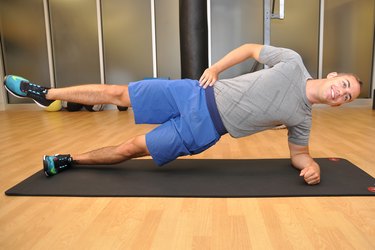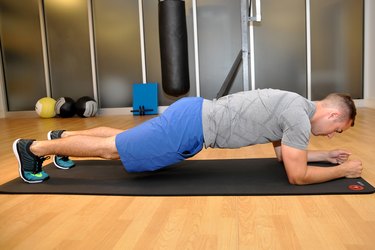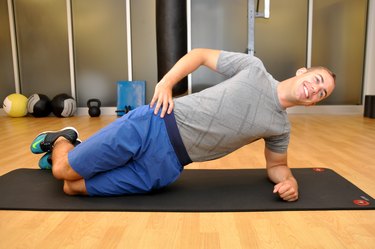
Nine hours, 30 minutes and 1 second: That's the world record for longest-held plank! But you don't have to be a planking superstar (thank goodness!) to get the core-strengthening benefits planks provide.
Beyond chiseling your abs, doing planks will strengthen your entire core, which can help prevent back pain and improve your posture, according to Harvard Health Publishing.
Video of the Day
Video of the Day
Planks are also relatively straightforward to learn, and you can do them just about anywhere. And if you're getting bored with the standard plank exercise, you can try any of these other plank variations to break up the monotony.
1. Forearm Plank

- Get down on all fours on the floor and put your elbows and forearms on a comfortable surface (like a mat, towel or carpeted floor).
- Extend your legs back behind you and push up into a plank, creating a straight line from your shoulders to your ankles. Keep you neck in neutral alignment by looking at your hands.
- Hold this position without moving. Keep your hips level and squared to the ground and don't let your lower back arch.
Tip
If you’re new to planks (or just haven’t done them in a while), chances are you’ll start to shake when you get tired. But don’t let that intimidate you! Keep holding until you can’t hold your hips up anymore.
When you can't maintain proper form anymore, stop. Do three sets, holding as long as you can each time. When you can hold it for more than one minute, it’s time to move on to something more difficult.
2. Reaching Plank
- Start in a standard forearm plank.
- Slowly reach one arm forward until your elbow is straight.
- Pause for one second, then pull that arm back and plant your elbow so you're in the basic plank again.
- Alternate arms with each rep, aiming for 10 with each arm. Or do as many reps as you can with good form.
Tip
This variation requires more core stabilization because you’ll be moving your arms. Once you can do at least 10 reps with each arm, move on to a more advanced variation.
3. Bird-Dog Plank
- Start in a standard forearm plank.
- Reach your right arm forward until your elbow is straight. Simultaneously lift your left leg off the ground, keeping your knee straight.
- Hold this position a second, then lower your arm and leg into a plank again.
- Switch sides so you're lifting your left arm and right leg.
- Alternate sides as long as you can with good form.
Tip
This move requires balancing on one arm and one leg. This is a very challenging plank variation, and you’ll need lots of balance and strong arms and legs to hold yourself up.
Can't hold this variation without wobbling your hips? Start with the standard bird-dog exercise (where you're balancing on your knees instead of holding a plank) and lift your opposite arm and leg from there.
4. Plank Walk-Down
- Start in a high plank (the top of a push-up) balancing on your palms and toes, with your body forming a straight line from head to heels.
- Lower one forearm to the ground.
- Move the other arm down so both forearms are flat on the ground.
- Pause here briefly, then take the arm that went down first and plant that hand on the mat. Push yourself up on that side.
- Plant the other hand and push yourself back up to the starting position.
- On the next rep, switch the arm that goes down first. Do 5 reps leading with the first arm, then switch sides and do 5 reps leading with the other arm.
Tip
If you're rotating too much in the hips, move your feet out a bit wider to give you a better base of support.
5. Plank Kettlebell Drag
- Grab a relatively light kettlebell and set it next to you.
- Get into a forearm plank with the kettlebell on the outside of your left elbow.
- Reach your right hand behind your left elbow to grab the kettlebell.
- Drag the kettlebell all the way across your mat and place it outside of your right elbow.
- Place your right forearm down on the mat.
- Repeat with the left hand.
- Continue alternating sides as long as you can with good form.
6. Body Saw Plank
- Put sliders or towels under your feet and get into a forearm plank.
- Slowly slide your feet backward while maintaining a straight line from your head to your feet. Only slide back as far as you can with good form.
- Pull yourself back using your arms.
- Continue as long as you can while maintaining good form.
7. Modified Side Plank

- Lie on your right side, propped up on your right elbow. Bend your knees so your feet are behind you.
- Lean on your elbow and push your hips up toward the ceiling.
- Keep your hips in alignment with your spine.
- Hold this position for as long as you can with good form. Then repeat on the other side.
Tip
It may help to have a mirror in front of you for this exercise because you’ll want to make sure your body stays in a straight line. Letting your hips move forward or back or sag is one of the most common plank mistakes.
8. Side Plank

- Start lying on your right side and propped up on your right elbow. Keep your elbow directly under your right shoulder. Straighten your legs and stack your left foot on top of the right.
- Press your hips up off the ground. Make sure your hips are in line with your spine. The goal is to be as straight as possible.
- Hold this position for as long as you can with good form. Then repeat on the other side.
Tip
Once you can hold a side plank for at least 20 seconds on each side, you can move to a harder variation like the options below.
9. Side Plank Leg Raise

- Start in a standard side plank.
- Lift your top leg with your knee straight.
- Hold for one second, then lower back down to the starting position.
- Aim for 10 total reps before lowering down and switching sides.
10. Side Plank Hip Drop
- Start in a standard side plank.
- Drop your hips down as close to the floor as possible.
- Raise them straight up to the ceiling as high as possible. Avoid moving your hips forward or backward; try to only move them straight up and down.
- Keep moving from low to high for as many reps as you can with good form, then repeat on the other side.
Tip
If you’re having trouble keeping your hips straight, try doing this plank exercise a few inches in front of a wall. If you feel your butt touching the wall, it means your hips need to come forward.
11. Rotating Plank
- Start in a standard forearm plank.
- Keeping a straight line from head to toe, slowly roll over onto your right forearm so you're in a side plank. You can place your left hand on your hip if it helps you balance.
- Return to a standard forearm plank and pause for a second.
- Slowly roll over onto your left forearm so you're in a side plank on the opposite side.
- Continue alternating sides for as long as you can with good form.


